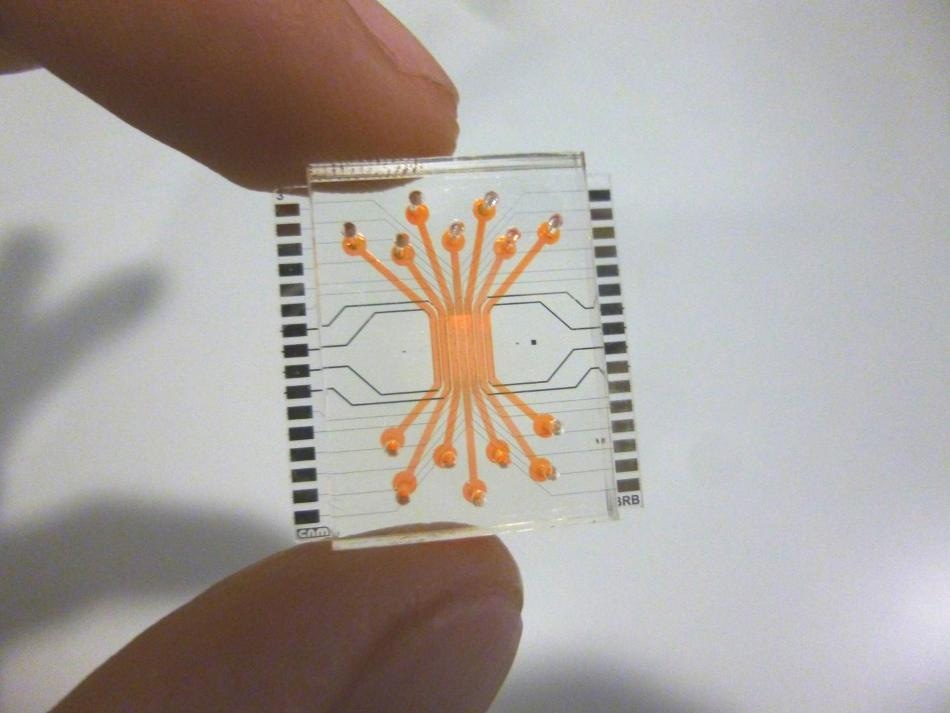Jan 24 2018
Over the past few years, researchers have been exploring a number of options to reduce animal testing and speed up clinical trials. One alternative is to use in vitro assays with living cells, but this method comes with certain limitations due to the problems reproducing the interaction and interconnection between cells.
 The new chip developed by Barcelona researchers. (Image credit: Jose Yuste (CSIC-IMB-CNM)
The new chip developed by Barcelona researchers. (Image credit: Jose Yuste (CSIC-IMB-CNM)
In order to overcome these limitations, researchers are developing new systems that emulate the functions of tissues and organs in almost real conditions. Such types of devices are known as "Organs-on-a-chip" and include microarquitectures and microenvironments to mimic the living tissues and organs.
A research team in Barcelona has designed a new microfluidic device that simulates the human blood-retinal barrier. The researchers are from the Biomedical Applications Group of the Microelectronics Institute of Barcelona (IMB-CNM) of the Spanisch Council for Scientific Research (CSIC), the Universitat Autònoma de Barcelona (UAB), the CIBER-BBN, and from the Diabetes and Metabolism group of the Vall d'Hebron Research Institute (VHIR), CIBERDEM- Institute of Health Carlos III.
Experts technically call the study as "proof of concept", i.e., it shows the viability of the design imagined by the researchers. The study was featured on the cover of the journal, Lab-on-a chip.
Emulating the Structure of the Blood-Retinal Barrier
José Yeste (main author of the study and a CSIC scientist at the IMB-CNM and the Microelectronics and Electronics Systems Department at the UAB) explains that the device contains a number of parallel compartments, which are arranged to mimic the retinal layer structure.
A type of cell has been cultured in each compartment: neuronal cells (which form the neuroretina), endothelial cells (which comprise of capillary vessels that carry nutrients and oxygen) and retinal pigmented epithelial cells, which form the external layer of the blood-retinal barrier.
A grid of microgrooves under the cells interconnects the compartments. These microgrooves allow the cells to exchange signal molecules and thus interact between them. Consequently, substances created by certain cells can reach the other cells and generate a cellular interaction and communication similar to a living organ. The device also makes it possible to expose the endothelial cells to the specific mechanical conditions, similar to the ones caused by the blood stream.
In the living organism, endothelial cells that cover the inner walls of blood vessels are exposed to the mechanical stimulus of the blood stream. In the cell cultures where this condition is not reproduced, we could say the cells are like "sleepy" and do not react as they would do in real conditions.
Rosa Villa, CSIC scientist and leader of the Biomedical Applications Group
The most relevant characteristic of this technology is that mimics what happens 'in vivo' in the retina and therefore can be an essential tool to boost the in vitro experimentation. On the device, the cells grow constantly in contact with a fluid, as it happens in the human retina. Also, the cells keep a close interaction between them by chemical mediators, which makes possible to see what happens in a type of cell when another type of cell nearby is harmed. Also, it is possible to measure electrical resistance for assessing the functionality of the retinal neurons.
Rafael Simó, Diabetes and Metabolism group of the Vall d'Hebron Research Institute (VHIR)
The researchers tested the exact formation of the blood-retinal barrier, reviewing its electrical resistance, its permeability, and the expression of certain proteins of the tight intercellular junctions. These proteins are expressed when a barrier function is established by cells.
The tests have been developed to find out whether the barrier was properly formed or not, without compromising the natural permeability to enable the passage of oxygen and nutrients and also to check whether the cells were remaining in contact and interacting properly.
According to scientists, this device can be used for examining the effects of harming conditions or molecules on the human retina.
The researchers also intend to utilize the device to get a better insight into diabetic retinopathy – a serious disorder whose progression and causes are yet to be fully understood.
Earlier, the team headed by Rosa Villa at the Microelectronics Institute of Barcelona (IMB-CNM) of the CSIC, did develop a device that mimics the blood-brain barrier. The researchers also created a microfluidic chamber (Liver-on-a chip) that emulates the hepatic microcirculation. In this study, they engineered and manufactured the device along with IDIBAPS scientists.